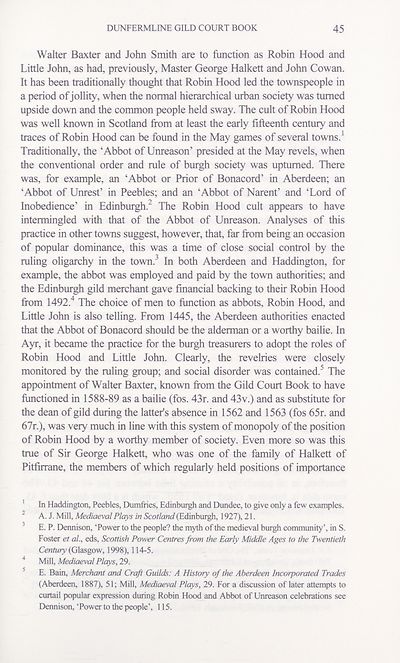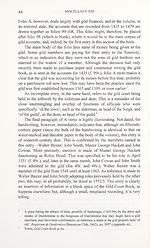Series 5 > Miscellany [of the Scottish History Society] XIII
(60) Page 45
Download files
Complete book:
Individual page:
Thumbnail gallery: Grid view | List view

DUNFERMLINE GILD COURT BOOK
45
Walter Baxter and John Smith are to function as Robin Hood and
Little John, as had, previously, Master George Halkett and John Cowan.
It has been traditionally thought that Robin Hood led the townspeople in
a period of jollity, when the normal hierarchical urban society was turned
upside down and the common people held sway. The cult of Robin Hood
was well known in Scotland from at least the early fifteenth century and
traces of Robin Hood can be found in the May games of several towns.1
Traditionally, the ‘Abbot of Unreason’ presided at the May revels, when
the conventional order and rule of burgh society was upturned. There
was, for example, an ‘Abbot or Prior of Bonacord’ in Aberdeen; an
‘Abbot of Unrest’ in Peebles; and an ‘Abbot of Narent’ and ‘Lord of
Inobedience’ in Edinburgh.2 The Robin Hood cult appears to have
intermingled with that of the Abbot of Unreason. Analyses of this
practice in other towns suggest, however, that, far from being an occasion
of popular dominance, this was a time of close social control by the
ruling oligarchy in the town.3 In both Aberdeen and Haddington, for
example, the abbot was employed and paid by the town authorities; and
the Edinburgh gild merchant gave financial backing to their Robin Hood
from 1492.4 The choice of men to function as abbots, Robin Hood, and
Little John is also telling. From 1445, the Aberdeen authorities enacted
that the Abbot of Bonacord should be the alderman or a worthy bailie. In
Ayr, it became the practice for the burgh treasurers to adopt the roles of
Robin Hood and Little John. Clearly, the revelries were closely
monitored by the ruling group; and social disorder was contained.5 The
appointment of Walter Baxter, known from the Gild Court Book to have
functioned in 1588-89 as a bailie (fos. 43r. and 43v.) and as substitute for
the dean of gild during the latter's absence in 1562 and 1563 (fos 65r. and
67r.), was very much in line with this system of monopoly of the position
of Robin Hood by a worthy member of society. Even more so was this
true of Sir George Halkett, who was one of the family of Halkett of
Pitfirrane, the members of which regularly held positions of importance
1 In Haddington, Peebles, Dumfries, Edinburgh and Dundee, to give only a few examples.
2 A. J. Mill, Mediaeval Plays in Scotland (Edinburgh, 1927), 21.
3 E. P. Dennison, ‘Power to the people? the myth of the medieval burgh community’, in S.
Foster et ai, eds, Scottish Power Centres from the Early Middle Ages to the Twentieth
Century (Glasgow, 1998), 114-5.
4 Mill, Mediaeval Plays, 29.
5 E. Bain, Merchant and Craft Guilds: A History of the Aberdeen Incorporated Trades
(Aberdeen, 1887), 51; Mill, Mediaeval Plays, 29. For a discussion of later attempts to
curtail popular expression during Robin Hood and Abbot of Unreason celebrations see
Dennison, ‘Power to the people’, 115.
45
Walter Baxter and John Smith are to function as Robin Hood and
Little John, as had, previously, Master George Halkett and John Cowan.
It has been traditionally thought that Robin Hood led the townspeople in
a period of jollity, when the normal hierarchical urban society was turned
upside down and the common people held sway. The cult of Robin Hood
was well known in Scotland from at least the early fifteenth century and
traces of Robin Hood can be found in the May games of several towns.1
Traditionally, the ‘Abbot of Unreason’ presided at the May revels, when
the conventional order and rule of burgh society was upturned. There
was, for example, an ‘Abbot or Prior of Bonacord’ in Aberdeen; an
‘Abbot of Unrest’ in Peebles; and an ‘Abbot of Narent’ and ‘Lord of
Inobedience’ in Edinburgh.2 The Robin Hood cult appears to have
intermingled with that of the Abbot of Unreason. Analyses of this
practice in other towns suggest, however, that, far from being an occasion
of popular dominance, this was a time of close social control by the
ruling oligarchy in the town.3 In both Aberdeen and Haddington, for
example, the abbot was employed and paid by the town authorities; and
the Edinburgh gild merchant gave financial backing to their Robin Hood
from 1492.4 The choice of men to function as abbots, Robin Hood, and
Little John is also telling. From 1445, the Aberdeen authorities enacted
that the Abbot of Bonacord should be the alderman or a worthy bailie. In
Ayr, it became the practice for the burgh treasurers to adopt the roles of
Robin Hood and Little John. Clearly, the revelries were closely
monitored by the ruling group; and social disorder was contained.5 The
appointment of Walter Baxter, known from the Gild Court Book to have
functioned in 1588-89 as a bailie (fos. 43r. and 43v.) and as substitute for
the dean of gild during the latter's absence in 1562 and 1563 (fos 65r. and
67r.), was very much in line with this system of monopoly of the position
of Robin Hood by a worthy member of society. Even more so was this
true of Sir George Halkett, who was one of the family of Halkett of
Pitfirrane, the members of which regularly held positions of importance
1 In Haddington, Peebles, Dumfries, Edinburgh and Dundee, to give only a few examples.
2 A. J. Mill, Mediaeval Plays in Scotland (Edinburgh, 1927), 21.
3 E. P. Dennison, ‘Power to the people? the myth of the medieval burgh community’, in S.
Foster et ai, eds, Scottish Power Centres from the Early Middle Ages to the Twentieth
Century (Glasgow, 1998), 114-5.
4 Mill, Mediaeval Plays, 29.
5 E. Bain, Merchant and Craft Guilds: A History of the Aberdeen Incorporated Trades
(Aberdeen, 1887), 51; Mill, Mediaeval Plays, 29. For a discussion of later attempts to
curtail popular expression during Robin Hood and Abbot of Unreason celebrations see
Dennison, ‘Power to the people’, 115.
Set display mode to:
![]() Universal Viewer |
Universal Viewer | ![]() Mirador |
Large image | Transcription
Mirador |
Large image | Transcription
Images and transcriptions on this page, including medium image downloads, may be used under the Creative Commons Attribution 4.0 International Licence unless otherwise stated. ![]()
| Scottish History Society volumes > Series 5 > Miscellany [of the Scottish History Society] XIII > (60) Page 45 |
|---|
| Permanent URL | https://digital.nls.uk/127314249 |
|---|
| Description | Over 180 volumes, published by the Scottish History Society, containing original sources on Scotland's history and people. With a wide range of subjects, the books collectively cover all periods from the 12th to 20th centuries, and reflect changing trends in Scottish history. Sources are accompanied by scholarly interpretation, references and bibliographies. Volumes are usually published annually, and more digitised volumes will be added as they become available. |
|---|


